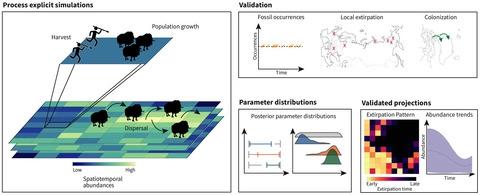当前位置:
X-MOL 学术
›
Glob. Change Biol.
›
论文详情
Our official English website, www.x-mol.net, welcomes your feedback! (Note: you will need to create a separate account there.)
Spatiotemporal influences of climate and humans on muskox range dynamics over multiple millennia
Global Change Biology ( IF 11.6 ) Pub Date : 2022-08-10 , DOI: 10.1111/gcb.16375 Elisabetta Canteri 1, 2 , Stuart C Brown 1, 3 , Niels Martin Schmidt 4 , Rasmus Heller 5 , David Nogués-Bravo 2 , Damien A Fordham 1, 2, 6
Global Change Biology ( IF 11.6 ) Pub Date : 2022-08-10 , DOI: 10.1111/gcb.16375 Elisabetta Canteri 1, 2 , Stuart C Brown 1, 3 , Niels Martin Schmidt 4 , Rasmus Heller 5 , David Nogués-Bravo 2 , Damien A Fordham 1, 2, 6
Affiliation

|
Processes leading to range contractions and population declines of Arctic megafauna during the late Pleistocene and early Holocene are uncertain, with intense debate on the roles of human hunting, climatic change, and their synergy. Obstacles to a resolution have included an overreliance on correlative rather than process-explicit approaches for inferring drivers of distributional and demographic change. Here, we disentangle the ecological mechanisms and threats that were integral in the decline and extinction of the muskox (Ovibos moschatus) in Eurasia and in its expansion in North America using process-explicit macroecological models. The approach integrates modern and fossil occurrence records, ancient DNA, spatiotemporal reconstructions of past climatic change, species-specific population ecology, and the growth and spread of anatomically modern humans. We show that accurately reconstructing inferences of past demographic changes for muskox over the last 21,000 years require high dispersal abilities, large maximum densities, and a small Allee effect. Analyses of validated process-explicit projections indicate that climatic change was the primary driver of muskox distribution shifts and demographic changes across its previously extensive (circumpolar) range, with populations responding negatively to rapid warming events. Regional analyses show that the range collapse and extinction of the muskox in Europe (~13,000 years ago) was likely caused by humans operating in synergy with climatic warming. In Canada and Greenland, climatic change and human activities probably combined to drive recent population sizes. The impact of past climatic change on the range and extinction dynamics of muskox during the Pleistocene–Holocene transition signals a vulnerability of this species to future increased warming. By better establishing the ecological processes that shaped the distribution of the muskox through space and time, we show that process-explicit macroecological models have important applications for the future conservation and management of this iconic species in a warming Arctic.
中文翻译:

数千年来气候和人类对麝牛分布动态的时空影响
在更新世晚期和全新世早期,导致北极巨型动物群范围收缩和种群数量下降的过程尚不确定,人们对人类狩猎、气候变化及其协同作用的作用进行了激烈辩论。解决方案的障碍包括过度依赖相关而非过程显式方法来推断分布和人口变化的驱动因素。在这里,我们理清了导致麝牛 ( Ovibos moschatus ) 衰退和灭绝的生态机制和威胁) 在欧亚大陆及其在北美的扩张使用过程显式宏观生态模型。该方法整合了现代和化石发生记录、古代 DNA、过去气候变化的时空重建、特定物种的种群生态学以及解剖学上现代人类的生长和传播。我们表明,准确重建过去 21,000 年麝香牛过去人口变化的推论需要高扩散能力、大的最大密度和小的 Allee 效应。对经过验证的过程显式预测的分析表明,气候变化是麝牛分布变化和其先前广泛(极地)范围内人口变化的主要驱动因素,人口对快速变暖事件做出负面反应。区域分析表明,欧洲麝牛的分布范围崩溃和灭绝(约 13,000 年前)很可能是人类与气候变暖协同作用造成的。在加拿大和格陵兰,气候变化和人类活动可能共同推动了最近的人口规模。过去的气候变化对更新世-全新世过渡期间麝牛的范围和灭绝动态的影响表明该物种对未来变暖加剧的脆弱性。通过更好地建立塑造麝牛在空间和时间上分布的生态过程,我们表明过程显式宏观生态模型对于未来在变暖的北极地区保护和管理这一标志性物种具有重要应用。000 年前)很可能是人类与气候变暖协同作用造成的。在加拿大和格陵兰,气候变化和人类活动可能共同推动了最近的人口规模。过去的气候变化对更新世-全新世过渡期间麝牛的范围和灭绝动态的影响表明该物种对未来变暖加剧的脆弱性。通过更好地建立塑造麝牛在空间和时间上分布的生态过程,我们表明过程显式宏观生态模型对于未来在变暖的北极地区保护和管理这一标志性物种具有重要应用。000 年前)很可能是人类与气候变暖协同作用造成的。在加拿大和格陵兰,气候变化和人类活动可能共同推动了最近的人口规模。过去的气候变化对更新世-全新世过渡期间麝牛的范围和灭绝动态的影响表明该物种对未来变暖加剧的脆弱性。通过更好地建立塑造麝牛在空间和时间上分布的生态过程,我们表明过程显式宏观生态模型对于未来在变暖的北极地区保护和管理这一标志性物种具有重要应用。过去的气候变化对更新世-全新世过渡期间麝牛的范围和灭绝动态的影响表明该物种对未来变暖加剧的脆弱性。通过更好地建立塑造麝牛在空间和时间上分布的生态过程,我们表明过程显式宏观生态模型对于未来在变暖的北极地区保护和管理这一标志性物种具有重要应用。过去的气候变化对更新世-全新世过渡期间麝牛的范围和灭绝动态的影响表明该物种对未来变暖加剧的脆弱性。通过更好地建立塑造麝牛在空间和时间上分布的生态过程,我们表明过程显式宏观生态模型对于未来在变暖的北极地区保护和管理这一标志性物种具有重要应用。
更新日期:2022-08-10
中文翻译:

数千年来气候和人类对麝牛分布动态的时空影响
在更新世晚期和全新世早期,导致北极巨型动物群范围收缩和种群数量下降的过程尚不确定,人们对人类狩猎、气候变化及其协同作用的作用进行了激烈辩论。解决方案的障碍包括过度依赖相关而非过程显式方法来推断分布和人口变化的驱动因素。在这里,我们理清了导致麝牛 ( Ovibos moschatus ) 衰退和灭绝的生态机制和威胁) 在欧亚大陆及其在北美的扩张使用过程显式宏观生态模型。该方法整合了现代和化石发生记录、古代 DNA、过去气候变化的时空重建、特定物种的种群生态学以及解剖学上现代人类的生长和传播。我们表明,准确重建过去 21,000 年麝香牛过去人口变化的推论需要高扩散能力、大的最大密度和小的 Allee 效应。对经过验证的过程显式预测的分析表明,气候变化是麝牛分布变化和其先前广泛(极地)范围内人口变化的主要驱动因素,人口对快速变暖事件做出负面反应。区域分析表明,欧洲麝牛的分布范围崩溃和灭绝(约 13,000 年前)很可能是人类与气候变暖协同作用造成的。在加拿大和格陵兰,气候变化和人类活动可能共同推动了最近的人口规模。过去的气候变化对更新世-全新世过渡期间麝牛的范围和灭绝动态的影响表明该物种对未来变暖加剧的脆弱性。通过更好地建立塑造麝牛在空间和时间上分布的生态过程,我们表明过程显式宏观生态模型对于未来在变暖的北极地区保护和管理这一标志性物种具有重要应用。000 年前)很可能是人类与气候变暖协同作用造成的。在加拿大和格陵兰,气候变化和人类活动可能共同推动了最近的人口规模。过去的气候变化对更新世-全新世过渡期间麝牛的范围和灭绝动态的影响表明该物种对未来变暖加剧的脆弱性。通过更好地建立塑造麝牛在空间和时间上分布的生态过程,我们表明过程显式宏观生态模型对于未来在变暖的北极地区保护和管理这一标志性物种具有重要应用。000 年前)很可能是人类与气候变暖协同作用造成的。在加拿大和格陵兰,气候变化和人类活动可能共同推动了最近的人口规模。过去的气候变化对更新世-全新世过渡期间麝牛的范围和灭绝动态的影响表明该物种对未来变暖加剧的脆弱性。通过更好地建立塑造麝牛在空间和时间上分布的生态过程,我们表明过程显式宏观生态模型对于未来在变暖的北极地区保护和管理这一标志性物种具有重要应用。过去的气候变化对更新世-全新世过渡期间麝牛的范围和灭绝动态的影响表明该物种对未来变暖加剧的脆弱性。通过更好地建立塑造麝牛在空间和时间上分布的生态过程,我们表明过程显式宏观生态模型对于未来在变暖的北极地区保护和管理这一标志性物种具有重要应用。过去的气候变化对更新世-全新世过渡期间麝牛的范围和灭绝动态的影响表明该物种对未来变暖加剧的脆弱性。通过更好地建立塑造麝牛在空间和时间上分布的生态过程,我们表明过程显式宏观生态模型对于未来在变暖的北极地区保护和管理这一标志性物种具有重要应用。



























 京公网安备 11010802027423号
京公网安备 11010802027423号